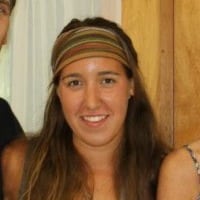Ann Heaslett trained every year for one race: the IAU 100k World Cup. (The race is now called the IAU 100k World Championships.)
Her first year, she made the 100k team as an alternate, traveling to France in 2001. In 2002, the race took her to Belgium, to Taiwan in 2003, to the Netherlands in 2004, and finally, in 2005, she helped Team USA bring home a gold medal from Japan. At these different races in different countries, she contended with many variables–food, travel, the course, weather, and more. But there was one constant that she and Team USA didn’t leave home without, and that’s her husband, Tim Yanacheck.
Ann ran onto the ultra scene as a late bloomer, and it is Tim who lovingly and proudly takes credit for getting her there. “I started ultrarunning before Ann, but what I like to say is that she was nothing until she met me,” Tim claimed. “I take credit for introducing her to ultramarathoning and I have been with her at every ultra she has ever run.”
“Yes,” Ann confirmed, “you were there.”
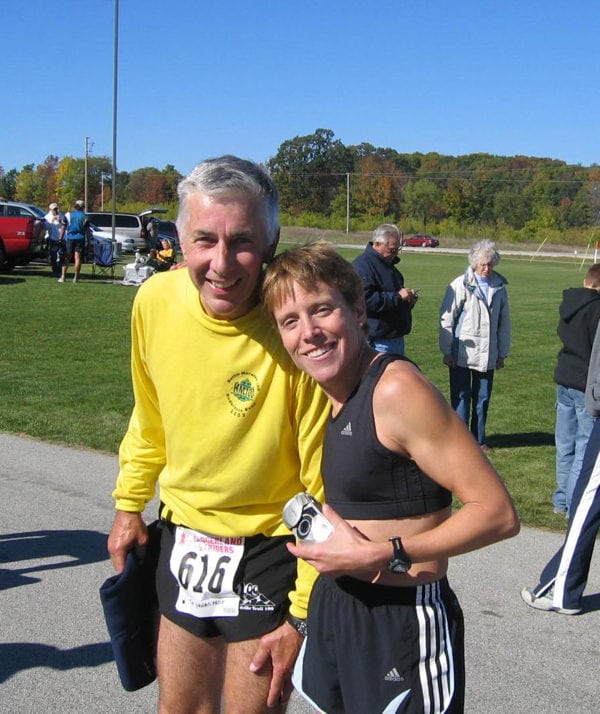
Ann Heaslett and Tim Yanacheck at the 2005 Glacial Trail 50k in Wisconsin. Photo: Tom Bunk
Ann and Tim (‘Timo,’ as most refer to him) met during a weekly group run in Madison, Wisconsin, falling in love over the love of the miles. They recently celebrated 11-and-a-half years of marriage, him at age 69 and she at 52. Both participants in high-school and college competitive running, running fast is a commonality the two share.
Ann began running on the boys team at her high school in Green Bay, Wisconsin since there were never enough girls for their own team, she said. She went on to run for the University of Wisconsin-La Crosse, majoring in pre-med. It was while attending medical school at the University of Wisconsin-Madison–running just for fun at this time–when she met Tim.
Tim was a young runner, beginning on the half-mile course his dad routed out for him to earn a Boy Scouts badge. He attended Carthage College as a Division III runner, before enlisting for two years in the U.S. Army. After, it was straight to Marquette Law School and on to practice civil law for the next 42 years. Tim retired in January of this year.
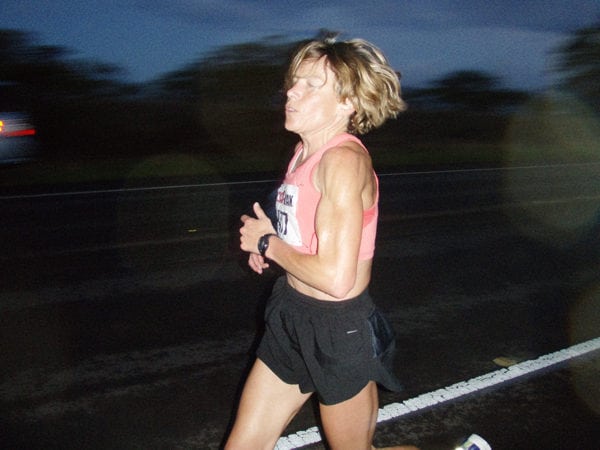
Ann racing in the 2009 Ultraman World Championships. All photos courtesy Ann Heaslett and Tim Yanacheck unless otherwise noted.
“I’ll brag about Ann, real quick,” Tim jutted in, the first of much bragging about Ann that he did during our interview. “She was inducted into the University of Wisconsin Wall of Fame, which is their version of a hall of fame.”
Ann went on to a career in state hospitals for psychiatry, working with adults and children who suffer from mental diseases.
When the two met, Tim had already figured out he was more of an ultrarunner breed, choosing Ice Age Trail 50 Mile as his first ultra. “I did have a great time,” he said of the first one. “I loved the trails and found I could keep up with the mid- and upper-pack. I wasn’t going anywhere in marathons. I had broken three hours twice but I was not close to the Olympic Marathon Trials or anything. It was just fun for me.” Ann, also a three-hour marathoner–“She ran 3:01 four times! You can’t run faster than that!” Tim injected again, affectionately–but like Tim, she found the trails more enjoyable. Plus, if she was going to run with Tim, it was trails or no run at all. “I just never put all my eggs in the road-running basket,” she said. “But then, I thought it was more fun to run trails and go longer.”

Tim running the 2005 Wisconsin Devils Run 5k/10k Run.
The Ice Age 50 Mile was also Ann’s first 50 miler and she has since completed it 10 times.
“Tim, I don’t know how many times you’ve done it?” she questioned.
“I don’t know either!” he exclaimed. “I’ve lost track.”
Race director Jeff Mallach cleared it up for them, saying Tim has finished the 50-mile race about six times and Ann 10 times, but that is just the 50-mile course. The pair also has a number of finishes in the event’s 50k and half-marathon distances. “Ann is a member of the Ice Age Trail 50 Mile 500-Mile Club (10 finishes),” Mallach said. “She won Ice Age in three consecutive years (2003 to 2005) and finished in the top three five other times.” She also won one of the 50k races and holds the masters record in the half marathon, he added.
Though the two didn’t race together over the next few years, they trained together and attended each other’s races as crew members and spectators. “I would crew Ann,” Tim said. “It is always a pleasure to crew Ann.” When Ann began running for a spot on Team USA to race the IAU 100k World Cup, Tim’s spectating position transformed into a much bigger role. “I am a good spectator,” he deemed. “I like to recognize people and see new people.”
Always accompanying Ann during the 100k race, Tim became the assistant manager of Team USA. He rented the car or bus, picked up the athletes, helped out at aid stations, and, perhaps most importantly, cheered on Ann and her teammates. “I love it. I don’t have to run and I get to enjoy the heck out of it,” he said of each trip. During the years Ann raced on Team USA, from 2001 to 2005, Tim said he loved watching every moment of her race.
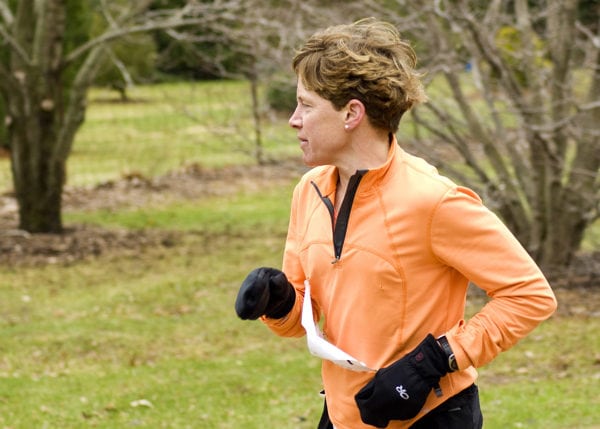
Ann racing in the 2008 Mad City 100k, the national-championship race directed by Tim.
“I was prouder than you can imagine, I still am.” Tim said. “The year she helped win the gold medal for the U.S. team, man, I was bawling my eyes out.”
Ann’s road to competing at an international level included winning the 2002 USATF 50-Mile Trail National Championships at the White River 50 Mile Endurance Run in Washington, running it in eight hours and 13 minutes, and the 2002 USATF 24-Hour National Championships during the Olander 24-Hour Relay and Endurance Challenge in Ohio, where she completed 128.55 miles.
At the 2002 IAU 100k World Cup in Belgium, Team USA finished third, and in 2005, in Japan, the team took first. During the four years Ann was on the team, she said the USA’s goal was to run together for as long as they could in the race. “We run slower and keep the pace steady for the first 50 to 80k, then we see what we had left,” she said. “I am not a strong finisher. I was always one of those Steady Eddys, finishing between third and fifth place on the team.” Ann raced alongside Nikki Kimball, Anne Lundblad, and Connie Gardner, among others, she said. The legendary Ann Trason was on the 100k teams before Ann, she added, though the two once ran a race together.
Over the years, one of the bigger changes they have witnessed is women from all over the world gaining more respect, not just because of faster finishing times, but overall as serious athletes. “Women are getting faster–men are too–but women are really getting faster,” Tim said. “Ann became the first woman ever, ever in the world, to run a 100-mile trail race in less than 16 hours, which has now been broken by several women. Women have come a long way in the sport. I’m a fan of that.”
National- and world-championship-level events are gaining in stature as well, Tim said, as more countries are joining and sending teams to compete. Races are being held in places most people would not travel to otherwise, he added. Qatar was unbelievably different, Gibraltar was so small the athletes slept on a cruise ship docked off the peninsula, and organizers in the Netherlands “really know how to put on a race,” Tim said.
Team USA is heading to Spain in late November for the 2016 IAU 100k World Championships. On the women’s team it’ll be Meghan Arbogast, Pam Smith, Sarah Bard, Camille Heron, and Traci Falbo. Team USA’s men are Zach Bitter, Matt Flaherty, Patrick Reagan, Nick Accardo, Joe Binder, Geoff Burns, Chikara Omine, and alternate Graham Peck. Due to injuries, the women’s team will compete with only five runners, Tim said.
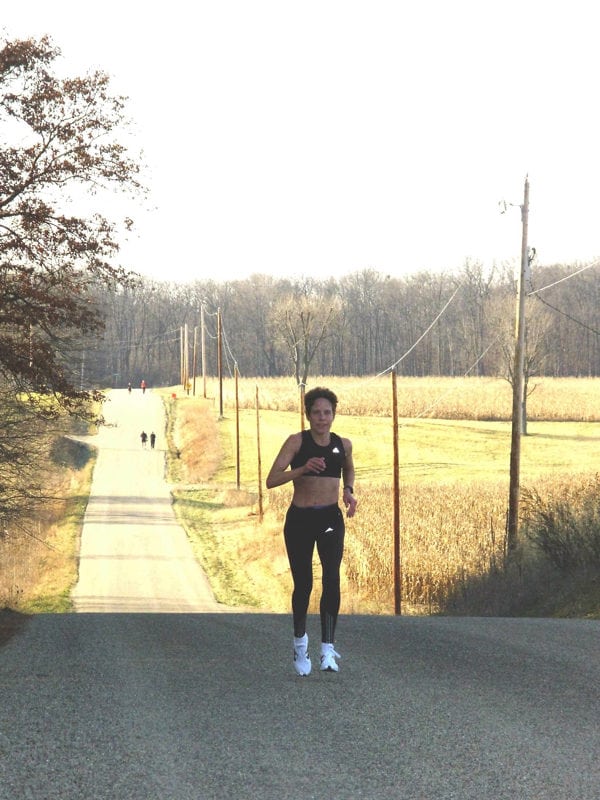
Ann running the last mile of the 2006 McNabb 50k in Illinois.
The team does not have an official coach. It’s up to each runner to get ready for the world championships, which often times takes place on a route not publicized until quite close to the event. “You do whatever training that got you through the national championships and onto the team,” Ann said. For her, that included a lower weekly mileage, numerous races, and a few hours a week in the pool. “I run a lot better in a race than in practice,” she said. While competing in the championship races, they were Ann’s ‘A’ goals, she said.
“That was the focus, to do whatever I needed to be ready to make that team and then to make the world race,” she said. “My philosophy was not going all out in every other race, but there were times, you know how it is when you’re in a race, you go harder in a race. I think that has made me be a better and faster runner.”
Prone to injuries, Ann’s string of championship races came to an early end, but her competitive nature drove her on. From 2005 to 2009, Ann switched her main focus to Ironman racing since she was already a runner and a swimmer. “I thought I would use my strength as an ultrarunner,” she said. “You really learn how to manage hydration and nutrition and I thought that would come in handy in Ironmans and it did.” Instead of miles of running, she would spend a day training on 100-mile bike rides. “It was intense in a different way,” she said. “I really enjoyed it, though.”
Ann qualified for the Ironman World Championships twice and competed in the Ultraman World Championships in Hawaii in 2007.
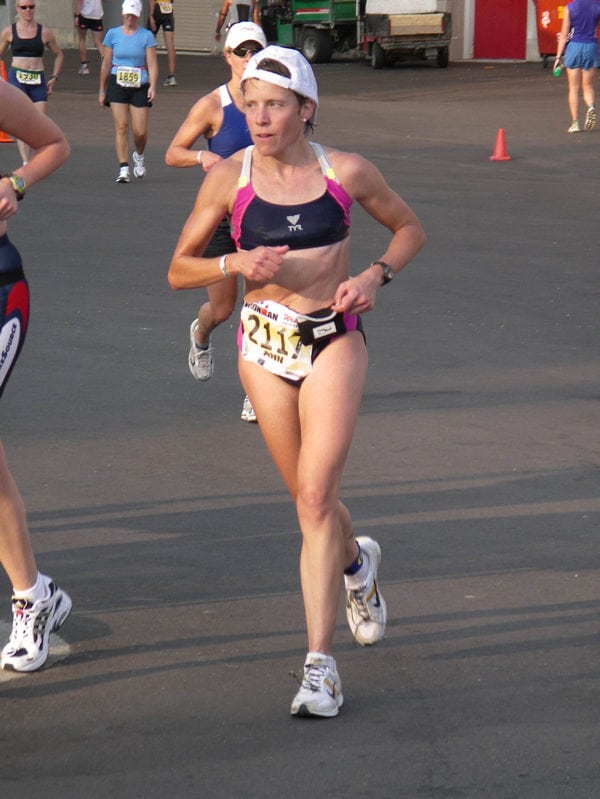
Ann competing in the 2005 Ironman Wisconsin.
During all these years, Ann continued to be a supporting member of the 100k championship team, along with Tim as one of the managers and helpers. In the 2006 race, held in North Korea, Team USA did not place well, according to Tim. So, over beers, Tim, the race manager, and doctor talked about a better way to keep the team more consistent. Their answer came in the idea of a qualifying race.
The doctor, Lion Caldwell, said he would donate $2,000 in prize money if Tim would put on the race. The race would be an annual, dependable, well-run championship course where runners could sign up to specifically earn a spot on the team and to run fast times. With the clinking of bottles, Tim and Caldwell agreed and the Mad City Ultras–100k, 50k solo, and 50k relay–began. The first one was run in 2007 and Tim has directed them ever since, welcoming fast and slower runners to Madison, Wisconsin every spring. The race is a certified 10k loop, wrapping around the University of Wisconsin-Madison Arboretum and Lake Wingra.
A half-flat, half-slightly-hilly course, the race allows people to come aiming for a goal time. The 100k male and female winners automatically receive a spot on the national team. This year it was Falbo and Burns who received automatic entries. Burns set a new course record this year in 6 hours and 30 minutes.
Other racers travel to the course seeking age-group records, Tim said. “Two years ago someone came to set the record for 80 year olds, and he did,” Tim said. “And last year a man came to set the record for the 50-to-54-year-old group, and he did. There are very slow runners and very fast runners, and the 50k course is not a championship race, but people just want to see if they can do it.”
After the first spot is filled, the USATF selects the remaining Team USA spots based on top 100k times and other qualifying standards.
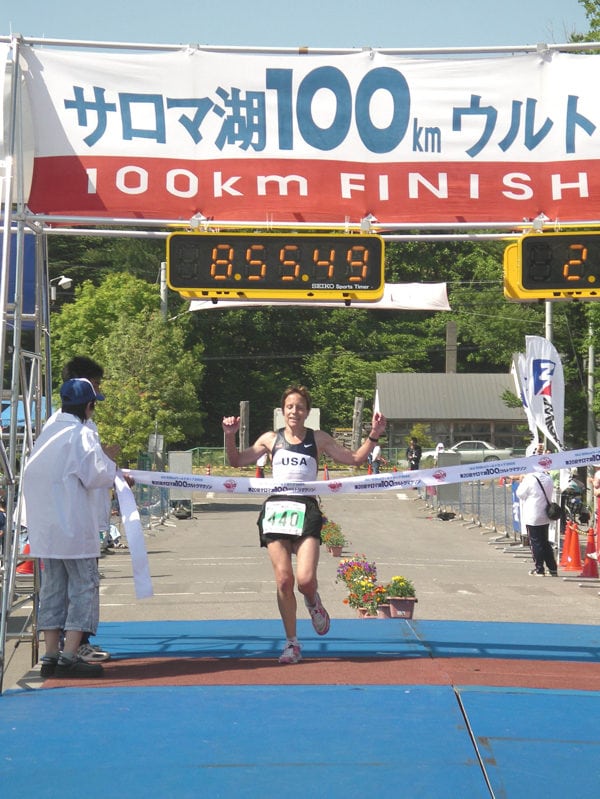
Ann crossing the finish line of the 2005 IAU 100k World Cup in Japan.
The course is set up for a fast race, with ample aid and great family access, Tim said. “It’s an ideal set-up for an ultra race for people in it for not just the scenery, but for the competition, just like the championship,” he said. “Not to say our course is not scenic; our course is beautiful. It is really pretty.” Starting up the race so quickly, and one with such caliber, was not a problem for Tim, who spent years helping out and years of race-directing experience already under his belt. In 2002, Tim took over the Kettle Moraine 100 Endurance Run, originally directed by Kevin and Kris Setnes. “At the time it was the only 100 miler in Wisconsin,” he said. “Everyone loved it so we [he and co-director Jason Dorgan] thought someone needed to keep it going.”
Tim, being a sub-24-hour finisher at the race, knew what it took to direct a successful race, but there was more to Tim’s personality that kept the race one of the top races in the Midwest. “Yes, it is very difficult,” Tim said of directing a yearly 100 miler. “But, I don’t see it like that. It is a sense of altruism, it’s a sense of giving, like donating blood.” He describes it as a public service, a thankless job in many ways. “Our race is an important opportunity for people and we realize how important it is every single year when people finish and how happy they are that someone gave them that opportunity,” he explained. “So that is my motivation.”
“Timo treats all his runners with respect,” Mallach said of his fellow Midwest race director. “It doesn’t matter if you win the Mad City 100k or are DFL at the Kettle 100 Mile, he’s there with a smile and a handshake. Timo and his co-director Dorgan are the reason many runners keep coming back to the Kettle 100 Mile.”
Ann’s current training consists of local half marathons, four to five weekly runs, and regular boot camp high-intensity workouts, she explained. Still working five days a week, leading two dogs to the dog walk, and running and working out, her life maintains its busy schedule. Tim, recently retired, keeps up with both races and has joined the local theater, singing and dancing. It was difficult the first few times that Ann accompanied the USA team as a spectator and not as a competitor, she said, but watching and cheering has gotten easier.
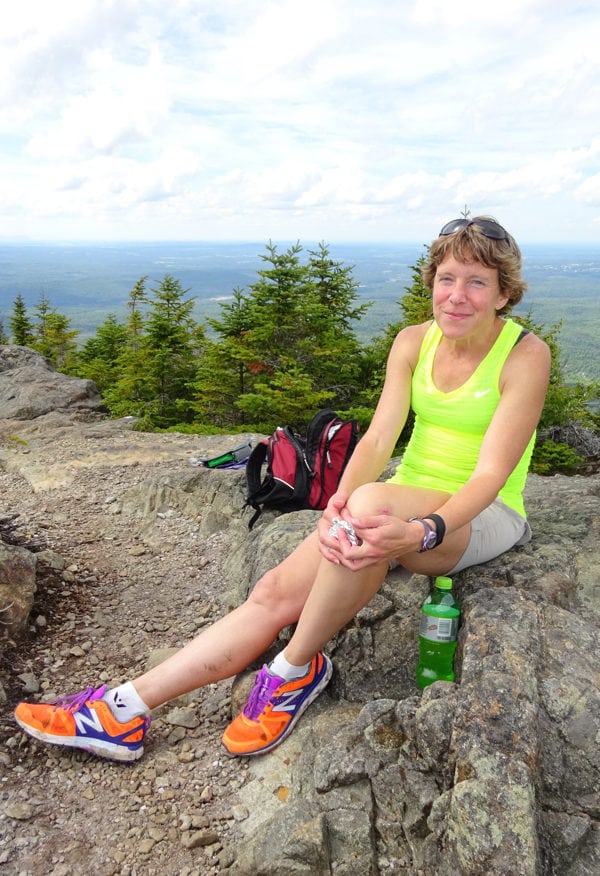
Ann stopping for the views on a hike through Mont Orford in Québec, Canada with Tim last year.
“Now, I enjoy working and volunteering,” she said of her niches of assisting at the championship races, other ultras, and at Tim’s races. “Ann and Timo are Ice Age volunteers,” Mallach added. “Welcoming and knowledgable, they are great ambassadors for Wisconsin ultrarunning, and ultrarunning in general.”
Tim’s love for watching people run, whether it is the fastest person on the course or while standing next to a group of volunteers in a foreign country, has brought him and Ann closer together. “Little Ann,” he calls her. “She is a beautiful runner, a toe runner, running on her forefoot. In marathons, she just puts down her head and runs as fast as she can. That’s the same kind of strength and character and determination she brings to ultramarathon running. I am proud to know her and I swell with pride when I see her run.”
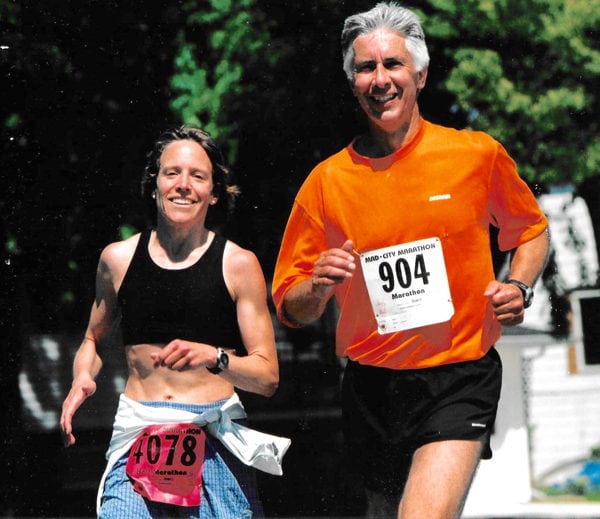
Ann and Tim together during the 2002 Madison Marathon.
